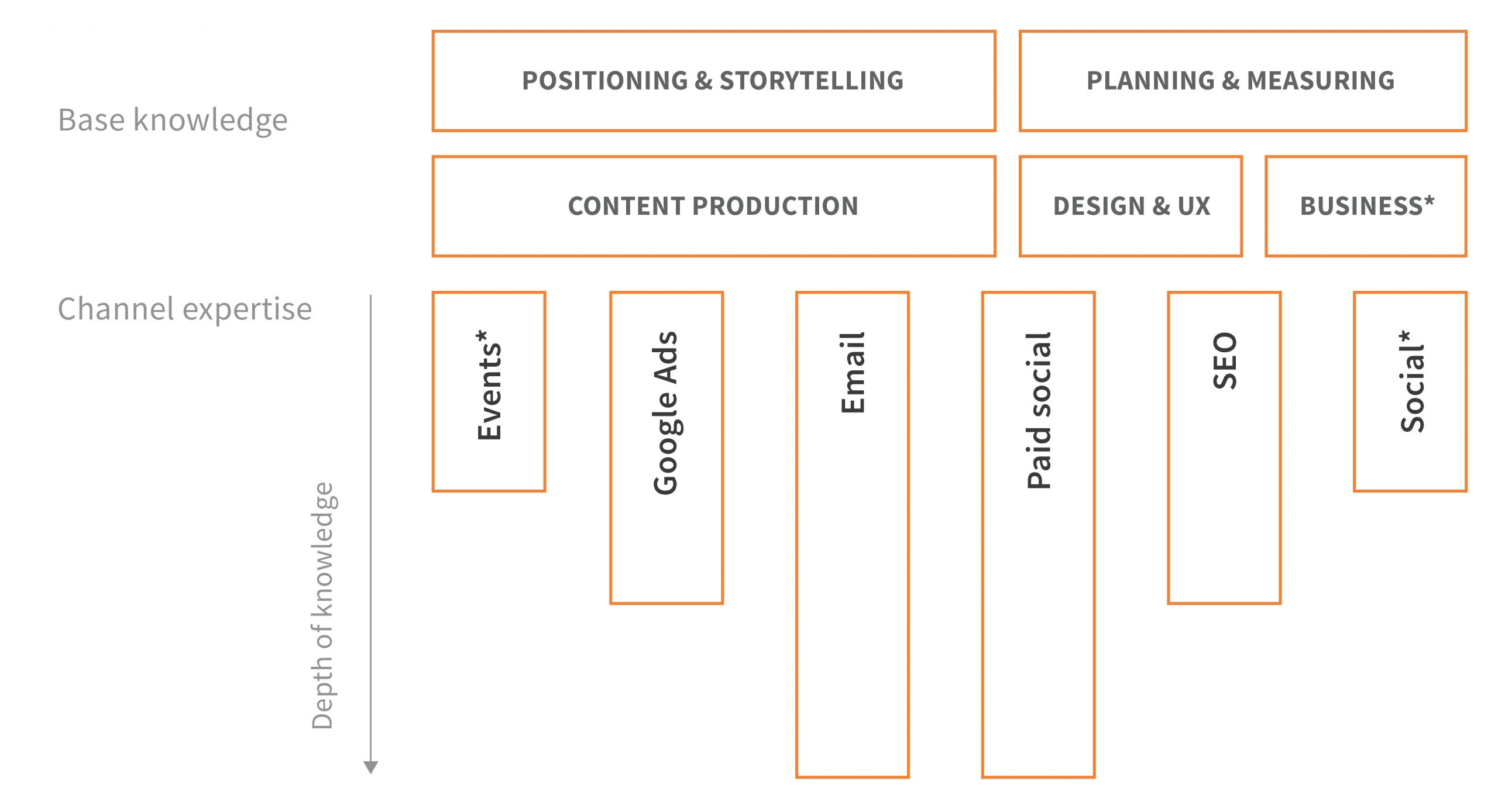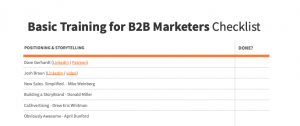I realized I enjoyed marketing sometime during grad school.
So I wanted to learn more about it. But have you tried Googling “marketing books”? Or “digital marketing courses”?
It’s overwhelming. There are hundreds of marketing topics to explore. I had no idea where to begin.
Five years later, I have a better grasp on what skillsets matter in marketing.
Without having mastered all of them, I now feel comfortable categorizing skills that make a great marketer.
The T-shaped marketer
Surprisingly, I’m not the first to do this. Crazy, I know. In fact, it’s been done so often that one “skill map” has emerged as the most popular: the “T-shaped marketer.”
According to this approach, your areas of expertise should be shaped like a ‘T.’ A broad education across disciplines at the top. A deep expertise in few channels at the bottom. Here is what I suggest that should look like for B2B marketers.

Getting a foundation in both base knowledge and relevant channels is like the first year of college. You get a feel for everything that’s out there before picking a degree. That’s what this article should do for you.
You may want a less-wordy version of it to print out.
You can access a checklist here.
Without further ado, let’s start with what I’d consider the most important base knowledge area.
Positioning and storytelling
Many marketers that are just getting started often overlook this skill set at first (I plead guilty). It’s easy to get entranced by new and shiny marketing technology or out-of-the-box ideas. When I started at Gorilla, I was trialing $30,000 attribution software and was fascinated by one company’s idea of sending miniature Ferraris to prospects.
These tools and tactics can be useful, of course. But before you use them, make sure you have a firm grasp on your company’s story. You should be able to answer questions like:
- Who does your company help? And more importantly: Who shouldn’t you be helping?
- What problems do you solve for them and how do you accomplish that?
- What makes you different?
- How do you communicate all that to the right people so they buy from you?
Below are the resources I recommend for answering these questions.
(Maybe you weren’t planning on reading sales books. But give them a chance. Your job is not so different from sales. Except that your ad, email or website is selling to hundreds or thousands at a time.)
Dave Gerhardt
Dave helped grow the software startup Drift into a $40 million company. He discusses marketing tactics, copywriting and positioning. You can follow Dave on LinkedIn and join his Patreon for $10/month.
Book: New Sales. Simplified. – Mike Weinberg
Weinberg provides a fantastic B2B positioning framework in chapter 8 and great sales & marketing advice all around (thanks to Joe for the reco).
Josh Braun
Josh is a sales trainer with great advice on crafting sales messages that resonate with prospects. Follow him on LinkedIn and check out this video for an introduction to his approach.
Book: Building a StoryBrand – Donald Miller
A great positioning and messaging framework for your toolbox. Miller teaches a simple but key marketing lesson: Each story has exactly one hero — your customer. Also highly recommended by fellow B2B marketers MJ Peters at Firetrace and our very own Trevor Wallis.
Book: Ca$hvertising – Drew Eric Whitman
Okay, the title is over the top. The dollar sign makes me die inside every time I see it. But this book has great tactical advice that’ll give you a solid foundation for creating ads.
Book: Obviously Awesome – April Dunford
A more recent (2019) addition to positioning literature but with a spin on product positioning, backed by 16 product launches worth of experience. Thanks to Matthew at Abicor Binzel for this addition.
Planning and measuring
For some, this is the place to nerd out. For others, this is spreadsheet hell. But without proper planning and measuring, you’re driving with your eyes shut (10 points for Gryffindor for that metaphor).
Basics on planning and measuring
Victor Cheng is the godfather of management consulting and training applicants for the interview process. This may seem a bit outside the marketing realm. But it has helped me structure my thinking and provided some great frameworks for solving business problems. Cheng’s website is a bit of a mess but read his book Case Interview Secrets.
In addition to that, read our article on visualizing your customer acquisition funnel. It will help you understand how to achieve revenue targets by reverse-engineering funnel metrics.
Make sure you’re striking a balance between short-term and long-term goals. This piece will help you understand the importance of brand marketing (despite the challenge of measuring it).
Tools
Providing training resources for each of the following tools would blow up this article. My goal is to show you which ones you really need (and maybe show you what you don’t need). Here’s our tech stack for measuring results:
- Google Analytics: Measure activity on your website
- Google Search Console: Detailed insight on keywords your site ranks for
- Google My Business: Calls and clicks from your local listing
- Google Tag Manager: Track conversions and install code snippets without a developer
- Google Data Studio: Create reports automatically (vs. manually pulling data every week)
- CRM: Measuring contact source, quality, sales cycle, close rate, revenue, etc; HubSpot works well for us
- CallRail: A great, intuitive tool for measuring phone calls and their origin
- Excel/Google Sheets pivot tables: Turn any dataset into segmented tables and graphs; it’ll save you thousands of hours throughout your career
You’ll find free courses on Google’s own training platforms or by experts on YouTube. If you’re looking for more advanced, in-depth courses, I recommend getting the CXL All-Access Pass for a few months ($59/month).
Content production
Done right, content marketing is the most powerful tool in B2B. By repeatedly solving your customers’ problems through content, you generate trust and demand. The below resources will give you a good idea of what makes great content and how to create it.
They Ask You Answer – Marcus Sheridan
When his swimming pool company tanked in 2008, Sheridan turned to content marketing to turn around his company. By answering every possible question about fiberglass pools (among other things), his company quickly became the go-to resource in the space. His story is a great primer for how to approach content production — simply answering your prospects’ questions.
Epic Content Marketing – Joe Pulizzi
Joe Pulizzi is the founder of the Content Marketing Institute and one of the first big names in content marketing. After reading it, print out the six principles he shares in this book and revisit them every time you’re about to write or as you plan upcoming content.
Gorilla on content marketing
Okay, let us brag a little here. We think we’re pretty darn good at content marketing. So we write about it often. Below are three pieces on our site you should read.
- What your content and wet dogs have in common
- How manufacturers can generate content marketing ideas
- How to extract expert knowledge from your team and turn it into incredible content
Design and UX
Whatever it is you’re doing in marketing, chances are that something visual needs to be created. Images, email templates and pages on your website are the vehicles that transport the message to your audience (that’s another 20 points, Harry).
Our design & UX team recommends the following two pieces as a small but meaningful foundation.
Book: Don’t Make Me Think, Revisited – Steve Krug
This is an introduction to usability. In Krug’s own words: “I wrote it for busy people who don’t do usability for a living, so it only covers what you really need to know.”
Design for non-designers (David Hall)
Hall briefly (and very entertainingly) summarizes five key design principles that you should be aware of. Read it here.
Website design: A few pieces on our site
We’ve designed our fair share of B2B websites. While doing so, we’ve identified a few keys to a great website build. If you’re planning a website project, you’ll find these articles helpful.
- If your website were a house: To repaint, rehab or rebuild
- The perfect home page
- The perfect case study
Acquisition channels and how to use them
Many (digital) marketers start out learning how acquisition channels work. At Gorilla, I started in SEO and inbound marketing. Others first learn how to optimize Google Ads or Facebook campaigns.
Understanding acquisition channels is fun because you can learn and get results fast. It’s very satisfying to see website traffic grow, more leads coming in, cost-per-click going down and so on.
But be careful not to get tunnel vision on your channels. Having a holistic training (i.e. other categories listed here) will help you understand how acquisition channels fit into the context of the business.
Here are foundational resources for key channels for B2B.
Paid social & email (content distribution)
Even the best content is useless if you don’t get the right eyes on it. For many B2B companies, content isn’t keyword-targeted. That means you need to find other distribution channels. Start by reading our article that addresses this distribution problem. Then read our introduction to Facebook & LinkedIn Ads for B2B, as well as Chris Walker’s article on Facebook Ads (and follow Chris on LinkedIn — he is THE expert on this topic).
Google Ads
Google’s own training is free and provides some basic understanding of how Google Ads works. But Google Ads is much more complex than that. Follow the “tips to minimize unqualified clicks” in this article religiously and get the CXL All-Access Pass for a month ($59) to take their Google Ads course.
SEO
SEO is often overcomplicated. In the end, ranking on Google comes down to three things: Great content answering questions (keywords), links from authoritative websites pointing to yours, and an easy-to-use website. Moz, the Google guru, dives deep into each of these factors in this guide. Sign up for the Moz Top 10 and Backlinko newsletter for ongoing education.
How to get started
Maybe you’ve already covered a lot of these resources and only want to fill some gaps. If you’re new to all this, you may not know where to start.
To get some momentum going, I would recommend reading Building a StoryBrand and New Sales. Simplified. Aside from learning a ton, they’re both fun reads that’ll motivate you to keep learning.
From there, work your way through these resources one week (or month – progress is progress) at a time.
You can use this downloadable overview as a quick reference. Print it out and cross things off as you go.
And if you think I missed something important on the list, shoot me a message.

